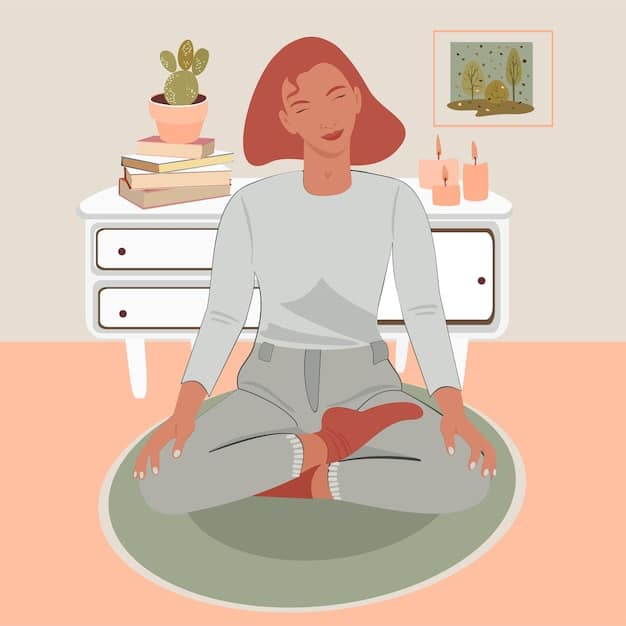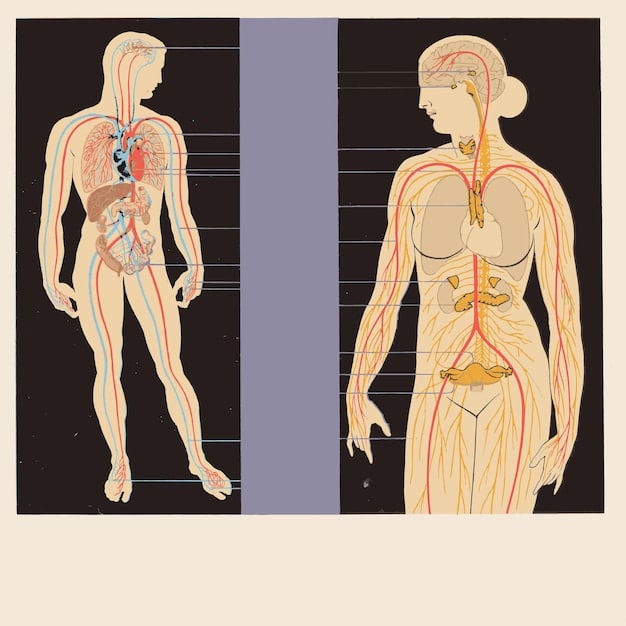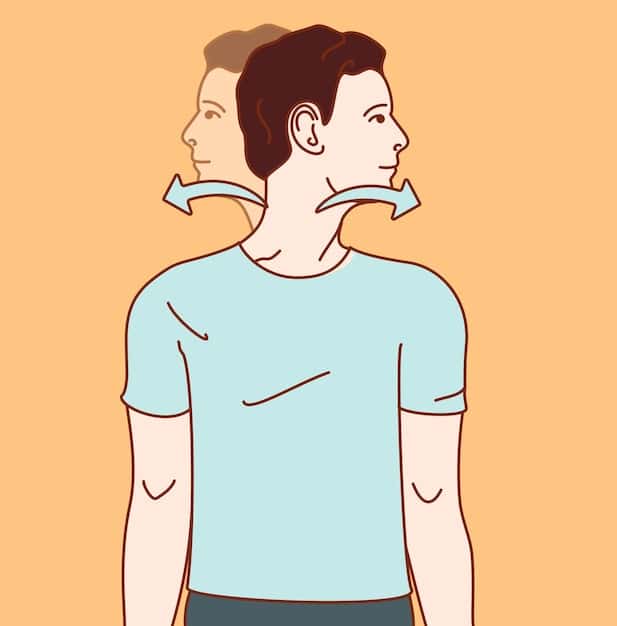The Science of Breathing: 5 Minutes to Calm Your Nerves

Diaphragmatic breathing, also known as belly breathing, leverages the body’s natural relaxation response by activating the parasympathetic nervous system, which can be achieved in just five minutes to effectively calm your nerves.
Feeling stressed? The science of breathing offers a simple, yet powerful solution. Discover how just 5 minutes of The Science of Breathing: How 5 Minutes of Diaphragmatic Breathing Can Calm Your Nerves can significantly reduce stress and anxiety.
Understanding the Science of Breathing and Stress
Breathing is something we do without thinking, but did you know that the way you breathe can have a profound impact on your stress levels? Understanding the mechanics and science behind breathing can help you take control of your body’s natural relaxation response.
The Autonomic Nervous System and Breathing
Our autonomic nervous system controls involuntary bodily functions like heart rate, digestion, and breathing. It has two main branches: the sympathetic nervous system (fight-or-flight) and the parasympathetic nervous system (rest-and-digest).
How Stress Affects Breathing Patterns
When we’re stressed, the sympathetic nervous system kicks in, leading to rapid, shallow breathing. This type of breathing can actually exacerbate feelings of anxiety and tension, creating a vicious cycle.

Diaphragmatic breathing, on the other hand, activates the parasympathetic nervous system, promoting relaxation and reducing stress hormones.
- Deep breathing encourages full oxygen exchange, slowing heart rate.
- It also helps to lower blood pressure, promoting relaxation..
- Activating the parasympathetic nervous system reduces the release of cortisol.
- Practicing mindful breathing can lead to long term stress reduction.
By consciously controlling your breath, you can influence your autonomic nervous system and shift your body into a state of calm. This simple act can be a powerful tool for managing stress and anxiety.
What is Diaphragmatic Breathing?
Diaphragmatic breathing, also known as belly breathing, is a technique that involves deep, slow breaths that expand the abdomen rather than just the chest. It’s a natural way to calm your nerves and promote relaxation.
It is about engaging the diaphragm, a large muscle located at the base of your lungs, to deepen your breaths and increase oxygen intake.
How Diaphragmatic Breathing Differs from Chest Breathing
Chest breathing is shallow and relies on the muscles in your upper chest and shoulders. It doesn’t allow for full lung expansion and can contribute to feelings of tension and anxiety.
The Benefits of Diaphragmatic Breathing
Diaphragmatic breathing offers several benefits, including reduced stress, lower blood pressure, improved focus, and increased energy levels. Regular practice can also help to improve sleep quality and overall well-being.
- Reduces heart rate and blood pressure.
- Increases oxygen flow and energy levels.
- Encourages a deeper sense of calm.
- Promotes better sleep quality.
Switching to diaphragmatic breathing can counter act the effects of rapid shallow breathing and can deliver increased energy to your body.
Diaphragmatic breathing is a simple yet effective technique for managing stress and promoting overall well-being. By consciously engaging your diaphragm, you can tap into your body’s natural relaxation response and improve your quality of life.
Step-by-Step Guide to 5-Minute Diaphragmatic Breathing
Ready to experience the calming benefits of diaphragmatic breathing? Follow this simple step-by-step guide to practice it for just 5 minutes each day.
Consistency is key, so try to incorporate this technique into your daily routine for optimal results.
Finding a Comfortable Position
Start by finding a comfortable position, either sitting or lying down. Make sure your body is relaxed and supported. You can close your eyes to help focus on your breath.
The 5-Minute Breathing Exercise
Place one hand on your chest and the other on your abdomen. Inhale slowly through your nose, allowing your abdomen to rise while keeping your chest relatively still. Exhale slowly through your mouth, feeling your abdomen fall. Repeat this process for 5 minutes, focusing on the sensation of your breath.

- Inhale deeply and slowly through your nose for 4 seconds.
- Hold your breath briefly for 1-2 seconds.
- Exhale slowly through your mouth for 6 seconds.
- Repeat this cycle for 5 minutes.
By following this simple guide, you can easily incorporate diaphragmatic breathing into your daily routine and experience its many benefits.
This technique can be a valuable tool for managing stress, anxiety, and improving both physical and mental well-being.
The Psychological Impact of Diaphragmatic Breathing
Beyond the physical benefits, diaphragmatic breathing has a significant psychological impact on our mental and emtional health.
By consciously controlling our breath, we can influence our mood, reduce anxiety, and promote overall psychological well-being.
Reducing Anxiety and Stress
Diaphragmatic breathing activates the parasympathetic nervous system, which helps to reduce the production of stress hormones like cortisol. This can lead to a significant decrease in anxiety and stress levels.
Improving Mood and Emotional Regulation
Deep breathing exercises have been shown to improve mood and emotional regulation. By calming the mind and body, diaphragmatic breathing can help to promote a sense of inner peace and balance.
Mindful breathing can also help to increase self-awareness and emotional resilience.
- Diaphragmatic breathing helps to lessen symptoms of depression.
- Practice can also increase emotional awareness.
- It also can promote a greater sense of mindfullness.
- It can also help with emotional regulation.
Diaphragmatic breathing can be a powerful tool for improving mood, managing anxiety, and promoting emotional well-being. By incorporating this technique into your daily routine, you can enhance your psychological health.
By consciously controlling your breath, you can positively influence your thoughts, feelings, and overall sense of self.
Incorporating Diaphragmatic Breathing Into Your Daily Routine
Integrating diaphragmatic breathing into your daily life is easier than you might think.
By finding opportunities to pause and focus on your breath, you can reap the benefits of this technique throughout the day.
Finding Time to Practice
Set a timer for 5 minutes and find a quiet space where you can relax and focus on your breath. This can be done first thing in the morning, during your lunch break, or before bed.
Using Breathing as a Stress Management Tool
Whenever you feel overwhelmed or anxious, take a few minutes to practice diaphragmatic breathing. This can help to calm your nerves and regain a sense of control.
Diaphragmatic breathing can be used in stressful situations, such as before a presentation or during a difficult conversation.
- Use breathing techniques while driving.
- Use while at your desk.
- Use while in line.
- Use while waiting for an important meeting.
Incorporating diaphragmatic breathing into your daily routine can be a game-changer for your stress levels and overall well-being.
By finding opportunities to pause and focus on your breath, you can train your body to respond to stress in a more calm and balanced way.
Advanced Tips and Techniques for Breathing Exercises
Once you’ve mastered the basics of diaphragmatic breathing, you can explore more advanced techniques to deepen your practice and enhance its benefits.
Experiment with different breathing patterns and visualizations to find what works best for you.
Combining Breathing with Meditation
Combining diaphragmatic breathing with meditation can amplify its calming effects. Focus on your breath as you meditate, allowing your mind to settle and your body to relax.
Exploring Different Breathing Ratios
Experiment with different inhale-to-exhale ratios to find what feels most comfortable and effective for you. For instance, you might try inhaling for a count of four and exhaling for a count of six.
Different breathing ratios can have different effects on your nervous system and emotional state.
- Try different breathing exercises besides the one described above.
- Try alternate nostril breathing.
- Use different breathing techniques for different situations.
- Learn more about proper breathing techniques in different meditation and martial art practices.
By exploring advanced tips and techniques, you can tailor your breathing practice to meet your individual needs and preferences.
Remember to be patient with yourself and to listen to your body as you experiment with different approaches.
| Key Point | Brief Description |
|---|---|
| 🧘 Deep Breathing | Promotes relaxation and reduces stress. |
| ❤️ Lowers Heart Rate | Slows heart rate and increases relaxation. |
| 😌 Mindfullness | Greater mind-body awareness. |
| 💪 Stress Management | Empowers individuals with a simple and effective tool for daily stress reduction. |
Frequently Asked Questions
▼
Diaphragmatic breathing, or belly breathing, is a deep breathing technique that involves contracting the diaphragm to draw air deep into the lungs, promoting relaxation and reducing stress.
▼
It activates the parasympathetic nervous system, which helps slow heart rate, lower blood pressure, and reduce stress hormones like cortisol, leading to a state of relaxation and calm.
▼
Practicing diaphragmatic breathing for just 5-10 minutes daily can significantly reduce stress and improve overall well-being. Regular practice enhances its benefits over time.
▼
Yes, it can improve sleep quality by reducing anxiety, promoting relaxation, and preparing your body for rest. Practicing it before bed can help you fall asleep faster.
▼
It is generally safe for most people. However, if you experience dizziness or hyperventilation, stop and adjust your technique. Consult a healthcare professional if you have concerns.
Conclusion
In conclusion, mastering the science of breathing: how 5 minutes of diaphragmatic breathing can calm your nerves is a simple yet powerful tool for managing stress, improving well-being, and enhancing your quality of life. By integrating this technique into your daily routine, you can take control of your body’s natural relaxation response and cultivate a greater sense of calm and balance.





